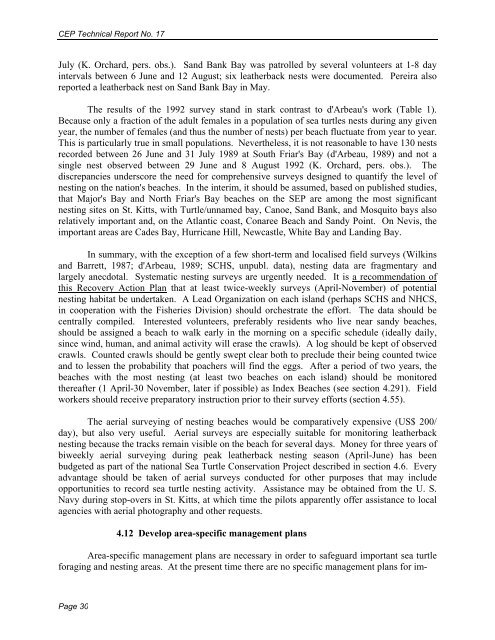Sea Turtle Recovery Action Plan for St. Kitts and Nevis - WIDECAST
Sea Turtle Recovery Action Plan for St. Kitts and Nevis - WIDECAST
Sea Turtle Recovery Action Plan for St. Kitts and Nevis - WIDECAST
Create successful ePaper yourself
Turn your PDF publications into a flip-book with our unique Google optimized e-Paper software.
CEP Technical Report No. 17<br />
July (K. Orchard, pers. obs.). S<strong>and</strong> Bank Bay was patrolled by several volunteers at 1-8 day<br />
intervals between 6 June <strong>and</strong> 12 August; six leatherback nests were documented. Pereira also<br />
reported a leatherback nest on S<strong>and</strong> Bank Bay in May.<br />
The results of the 1992 survey st<strong>and</strong> in stark contrast to d'Arbeau's work (Table 1).<br />
Because only a fraction of the adult females in a population of sea turtles nests during any given<br />
year, the number of females (<strong>and</strong> thus the number of nests) per beach fluctuate from year to year.<br />
This is particularly true in small populations. Nevertheless, it is not reasonable to have 130 nests<br />
recorded between 26 June <strong>and</strong> 31 July 1989 at South Friar's Bay (d'Arbeau, 1989) <strong>and</strong> not a<br />
single nest observed between 29 June <strong>and</strong> 8 August 1992 (K. Orchard, pers. obs.). The<br />
discrepancies underscore the need <strong>for</strong> comprehensive surveys designed to quantify the level of<br />
nesting on the nation's beaches. In the interim, it should be assumed, based on published studies,<br />
that Major's Bay <strong>and</strong> North Friar's Bay beaches on the SEP are among the most significant<br />
nesting sites on <strong>St</strong>. <strong>Kitts</strong>, with <strong>Turtle</strong>/unnamed bay, Canoe, S<strong>and</strong> Bank, <strong>and</strong> Mosquito bays also<br />
relatively important <strong>and</strong>, on the Atlantic coast, Conaree Beach <strong>and</strong> S<strong>and</strong>y Point. On <strong>Nevis</strong>, the<br />
important areas are Cades Bay, Hurricane Hill, Newcastle, White Bay <strong>and</strong> L<strong>and</strong>ing Bay.<br />
In summary, with the exception of a few short-term <strong>and</strong> localised field surveys (Wilkins<br />
<strong>and</strong> Barrett, 1987; d'Arbeau, 1989; SCHS, unpubl. data), nesting data are fragmentary <strong>and</strong><br />
largely anecdotal. Systematic nesting surveys are urgently needed. It is a recommendation of<br />
this <strong>Recovery</strong> <strong>Action</strong> <strong>Plan</strong> that at least twice-weekly surveys (April-November) of potential<br />
nesting habitat be undertaken. A Lead Organization on each isl<strong>and</strong> (perhaps SCHS <strong>and</strong> NHCS,<br />
in cooperation with the Fisheries Division) should orchestrate the ef<strong>for</strong>t. The data should be<br />
centrally compiled. Interested volunteers, preferably residents who live near s<strong>and</strong>y beaches,<br />
should be assigned a beach to walk early in the morning on a specific schedule (ideally daily,<br />
since wind, human, <strong>and</strong> animal activity will erase the crawls). A log should be kept of observed<br />
crawls. Counted crawls should be gently swept clear both to preclude their being counted twice<br />
<strong>and</strong> to lessen the probability that poachers will find the eggs. After a period of two years, the<br />
beaches with the most nesting (at least two beaches on each isl<strong>and</strong>) should be monitored<br />
thereafter (1 April-30 November, later if possible) as Index Beaches (see section 4.291). Field<br />
workers should receive preparatory instruction prior to their survey ef<strong>for</strong>ts (section 4.55).<br />
The aerial surveying of nesting beaches would be comparatively expensive (US$ 200/<br />
day), but also very useful. Aerial surveys are especially suitable <strong>for</strong> monitoring leatherback<br />
nesting because the tracks remain visible on the beach <strong>for</strong> several days. Money <strong>for</strong> three years of<br />
biweekly aerial surveying during peak leatherback nesting season (April-June) has been<br />
budgeted as part of the national <strong>Sea</strong> <strong>Turtle</strong> Conservation Project described in section 4.6. Every<br />
advantage should be taken of aerial surveys conducted <strong>for</strong> other purposes that may include<br />
opportunities to record sea turtle nesting activity. Assistance may be obtained from the U. S.<br />
Navy during stop-overs in <strong>St</strong>. <strong>Kitts</strong>, at which time the pilots apparently offer assistance to local<br />
agencies with aerial photography <strong>and</strong> other requests.<br />
4.12 Develop area-specific management plans<br />
Area-specific management plans are necessary in order to safeguard important sea turtle<br />
<strong>for</strong>aging <strong>and</strong> nesting areas. At the present time there are no specific management plans <strong>for</strong> im-<br />
Page 30
















